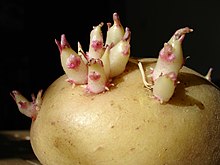Tuber
A plant tuber is a fleshy, thickened storage organ of plants that usually grows underground. Many wild flowering plants form tubers that live on underground when the above-ground shoot parts wither, and then resprout in the next growing season, such as lesser celandine and Canary bellflower. Among the plants whose tubers are planted in gardens are the dahlias and the yacon.
Plant tubers used in agriculture are also called tuber vegetables or tuber fruits, although they are not fruits in the botanical sense. Plant tubers are metamorphoses of the basic plant organs shoot axis (shoot tuber) or root (root tuber). The tuber serves plants to store reserve substances and to survive unfavorable living conditions such as winter or drought. Bulbs, unlike tubers, are metamorphoses of the shoot axis and leaves, with the transformed leaves taking over the storage function. The best known tubers are the edible shoot tubers of the potato. Root tubers are found in cassava, yams and yacon.
Shoot tubers may be formed by severe thickening of the hypocotyl or may arise from shoot internodes. Pure hypocotyl tubers are developed by cyclamen as well as numerous biennial plants such as radish or beet. Kohlrabi has a typical shoot tuber formed by higher leafy shoot segments. The underground shoot tubers differ from the rhizomes in greater thickness, limited growth, and usually absence of roots.
· 
Sprouting tuber of Canarina canariensis
· 
Dahlia tubers dug
· 
Tubers of cyclamen
·
Sweet potato root tubers
· 
Tubers of the yacon
· .jpg)
Kohlrabi with leafy sprout tuber
· 
Epiphytic orchid with shoot bulbs resembling onion leaves
Many epiphytes with xeromorphic construction have developed shoot tubers as water reservoirs to rapidly collect precipitation, such as some epiphytic orchids of the genus Oncidium.
In legumes, nodule bacteria live in thickenings of the root. However, these nodules are not tubers in the sense discussed here.

Sprouting shoot tuber of potato (Solanum tuberosum)
Root tuber anatomy
Root tubers show the typical structure of the cormophyte root; the central cylinder surrounded by a secondary endodermis with pericycle, xylem and phloem strands and surrounding cortical layer. This cortical layer is transformed into a large cell starch storage parenchyma in the root tuber by the incorporation of many comparatively large amyloplasts. Furthermore, the differentiation of the amyloplasts in the formation zone of the storage parenchyma around the central cylinder is shown.
Search within the encyclopedia
